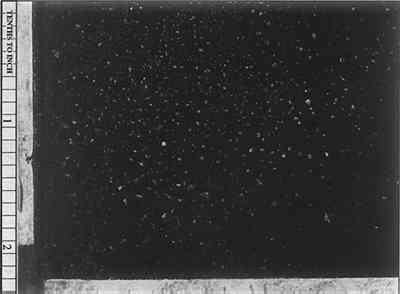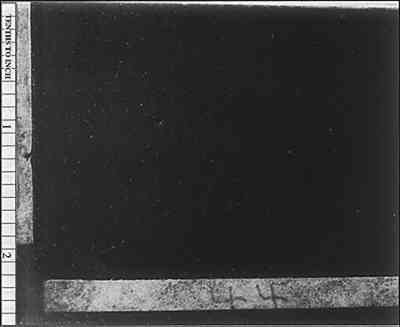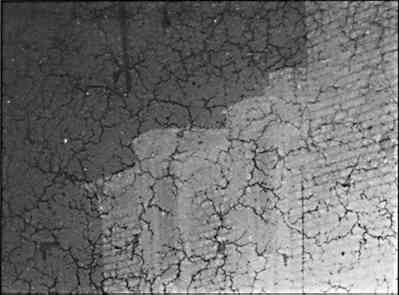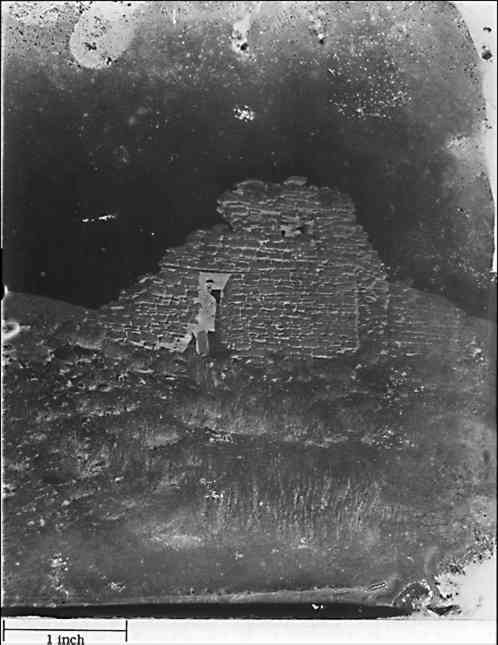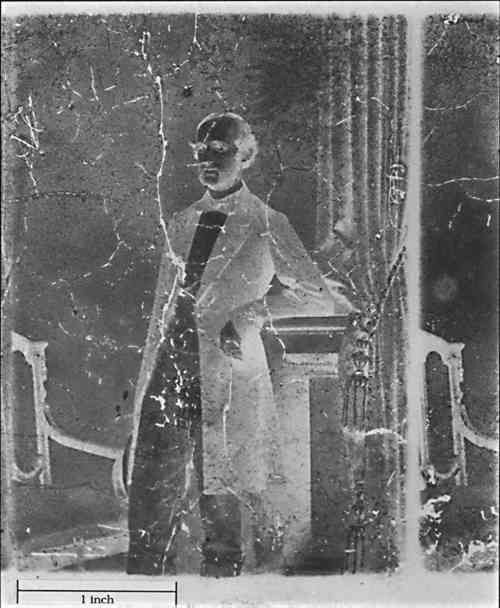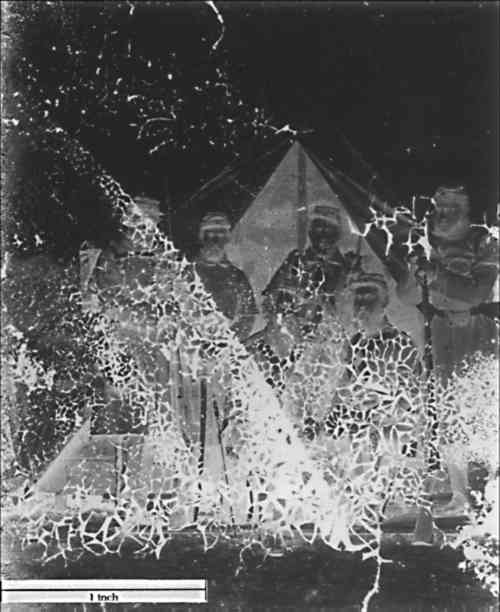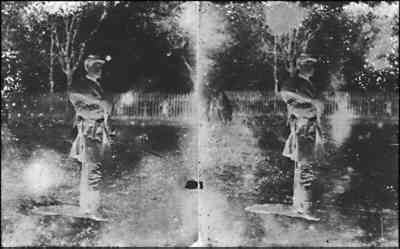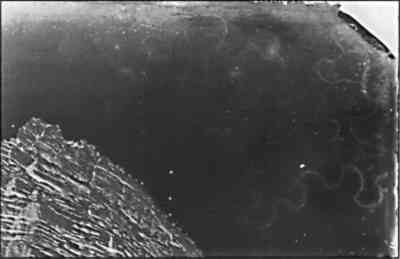PRESERVATION OF 19TH-CENTURY NEGATIVES IN THE NATIONAL ARCHIVESCONSTANCE McCABE
5 CONDITION AND DETERIRATIONTHE PHYSICAL fragility and chemical complexity of the component structure of glass plate negatives combine to create complicated preservation problems. The many variations of formulas used by the photographers for sensitized collodion, developers, flxers, post-processing treatments, and varnishes, as well as the types of glass employed, pose difficult questions for the preservation needs of these collections. 5.1 GLASS DETERIORATIONThe moisture-related deterioration of the glass component of some negatives was a major factor in the decision to undertake a large-scale preservation project at the National Archives aimed at arresting further damage to these valuable photographs. Until recently, glass had not been considered a factor in the deterioration of photographic plates. However, some glass negatives at the National Archives underwent changes in their physical character, evident as a crystalline or slippery deposit on the nonimage side of the plate and as binder and warnish lifting and/or softening on the image side of the plate. These changes are associated with variations in environmental conditions. When the relative humidity in the storage environment is dry, surface deposits on the nonimage side of the plate appear crystalline; at higher relative humidity, the deposits appear moist (figs. 24–26). These observations, as well as literature with alarming statements about the chemical instability of some glass types, indicate that some glasses produced during the 19th century are chemically unstable and that some 19th-century negatives were made with glass that has deteriorated (Segal et al. 1976; Simpson 1958, 1959; Brill 1978; Barger et al. 1989).
The collodion and varnish layers of plates that exhibit surface deposits on the nonimage side of the glass supports, as described above, characteristically develop some degree of softening, lifting, or flaking (figs. 27–30). The hygroscopic nature of the salts associated with glass decomposition (Moser 1961) can also contribute to silver image deterioration (Barger 1985), which is seen in a number of negatives in the holdings of the National Archives as localized fading or staining (figs. 31–32). Negatives that do not exhibit visible glass deterioration-related surface deposits are generally in very good conditions.
These observations led the National Archives Research and Testing Laboratory to carry out tests to confirm that the surface deposits on the 19th-century glass were, in fact, caused in large part by the deterioration of the glass supports. The secondary glass supports to which stereo negatives were attached date from the period during which the negatives were made.5 These secondary supports were used as test specimens (figs. Surface deposits from the secondry-support glass plates were rinsed with distilled water into sample cups for analysis by x-ray fluorescence. A blank was similarly prepared but by rinsing newly made window glass into the sample cups. With titanium being used as the target, the presence of silicon in the surface deposit was confirmed. No silicon was detected in the blank. There is no obvious source of silicon other than the glass itself, therefore it appears that the glass is chemically unstable and plays a role in the deterioration of the negative. An attempt was made to quantify the silicon present in the surface deposits of a deteriorated secondary support (one sample) and in the varnish and binder layers of 19th-century plates in both good condition (one sample) and poor condition (two samples) and in a blank consisting of any surface deposits of a piece of newly made window glass. The samples were prepared for analysis by rinsing the surfaces of the secondary support, the negative shards, and the blank with acetone and distilled water onto polyester film and allowing them to evaporate. The sample were then dissolved in a 70% solution of nitric acid and analysed using a Perkin-Elmer Model 2100 atomic absorption spectrometer (with a 2% standard deviation and a detection limit for silicon of 0.08 ppm). No silicon was detected in the blank, but silicon was detected in all other samples, in quantities ranging from 0.01 ppm to 1.42 ppm. However, no correlation could be made regarding the quantity of silicon as it relates to deterioration. The lack of correlation appears to be due to the small sample size involved (non uniform surface area of less then 2 � 2 cm), which made weighting the samples difficult. This prelimlnary investigation suggests that a more thorough study should be undertaken, with a more easily measurable and larger statistical sampling, to understand better the role of glass deterioration as it relates to collodion negative preservation. 5.2 STABILITY OF OTHER COMPONENTSThe final image of a collodion negative is composed of very small particles of metallic silver. This silver image is susceptible to oxidative deterioration, which appears as fading or discoloration. Silver image deterioration may be caused by many inherent problems, such as poor original chemical processing, or by unstable constituent materials. External factors may also lead to or exacerbate image deterioration. These factors might include storage in an environment with atmospheric pollutants or elevated RH. Exposure to other oxidative sources, such as poor-quality storage enclosures, may also cause image deterioration. It may be difficult to determine the specific cause of deterioration in a 19th-century negative if the method of production and use and storage history of the plate are unknown. Much research has focused on the problems of silver image stability, and further discussion of this subject is beyond the scope of this paper. Collodion, the binder within which the silver particles are suspended, is composed of cellulose nitrate. Motion pictures and still photographs created on cellulose nitrate supports are known to be chemically unstable and, if not properly stored, will deteriorate over time. It has been speculated that collodion negatives, especially those that are vernished, are as unstable as negatives with a cellulose nitrate film support (Gillet et al. 1986). The condition of the negatives at the National Archives suggests, however, that the cellulose nitrate layer is less a factor in the deterioration of collodion negatives than is the glass used in their production. Cellulose nitrate is still used in today's photographic industry as an extremely thin adhesive subbing for some gelatin photographic films and The varnish formulations used to protect collodion negatives from abrasion are very similar to those employed in painting. Naturally occurring resins such as copal, dammar, sandarac, and mastic were usually dissolved in alcohol or benzine and applied to a warm negative. Photochemical deterioration associated with vernished paintings, such as yellowing, does not seem to be a serious factor in negative deterioration. Collodion negatives were made to be used by the printing-out process, during which they are subjected to intense sunlight. For the most part, negatives are stored in the dark, and few plates exhibit considerable damage that can be attributed to exposure to light. The varnishes used with collodion negatives were chosen for their resistance to abrasion and to damage from exposure to strong sunlight. Other properties of vernishes, however, may have preservation implications. As with many components of archival records, the varnish is susceptible to damage from poor storage conditions. Fluctuating temperature and relative humidity can lead to the degradation of the varnish layer, seen as cracking, lifting, and flaking. When combined with the decomposition products from the glass support, the vernish layer can become very soft and vulnerable to phyalcal damage. The damage associated with the varnish layer can lead to degradation of the underlying collodion layer and the silver image. |
